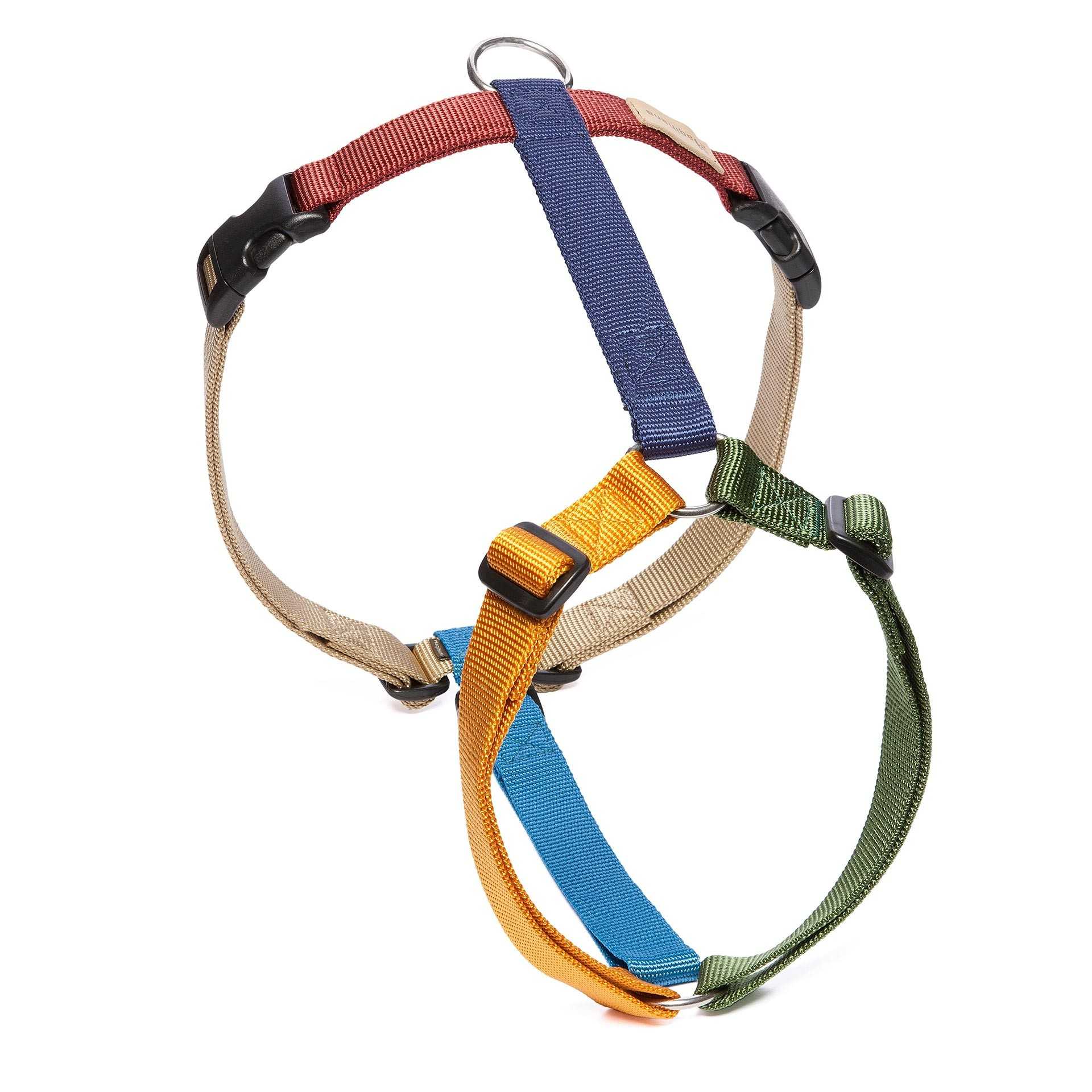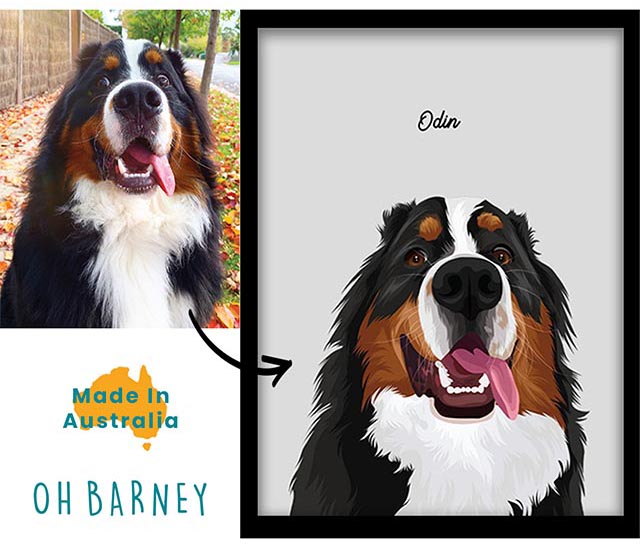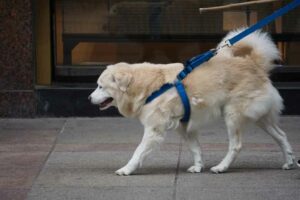Disclosure: Dogs of Australia is reader-supported. When you buy through links on our site, we sometimes earn an affiliate commission at no added cost to you. Learn more
When it comes to finding the best dog harness it’s important to make sure that you have the right design and that the harness is well-fitted.
All dogs are built differently, but most of the time you can tick those boxes with a Y-shaped harness that has adjustment straps on all sides.
If you have a timid dog, it can also be helpful to use a harness that fully opens on all sides, and therefore does not need to be pulled over your dog’s head.
But the gist of it really is that it’s more important to pick the right design than it is to buy a particular brand.
Table of Contents
ToggleOur Dog Harness Recommendation:
Finding the perfect harness might require some searching, but it’s worth it to ensure enjoyable walks for both you and your dog.
To help you get started, we recommend this harness that checks all our boxes at a reasonable price point:
PoyPet No Pull Dog Harness
✅ Easy to Use: Quick release snap buckles at the neck and chest for simple on and off, without the struggle of pulling it over the dog’s head.
✅ No Pull & No Choke: Designed with 2 metal leash attachments – front D-ring stops pulling and is great for training, back D-ring for casual walks. Evenly distributes pressure to prevent choking.
✅ Safe & Comfortable: Reflective straps for nighttime visibility and safety. A sturdy padded handle for quick control. Mesh lining for breathability, ensuring comfort all day.
✅ Adjustable Fit: Four adjustable straps for a customised fit. Soft, comfortable, and does not rub or irritate your dog’s skin.
What Other Harnesses Do We Like?
Here’s an overview of other dog harnesses that we like too!
The Perfect Fit Harness
It can be purchased via the Perfect Fit website (UK import) or a local retailer.
Key benefits:
- Modular design to guarantee a well-fitting harness, and
- Fully opens, which means that it doesn’t have to be pulled over your dogs head, which can be helpful for anxious dogs

Ruffwear Front Range Dog Harness
It can be purchased via Amazon or a local retailer.
Key benefits:
- Lightweight and durable design for all-day outdoor adventures
- 2 leash attachment points for additional control and training
- Foam-padded strips for equal load distribution and comfort, with 4 points of adjustment for a customisable fit.

Haqihana Harness (for dogs of all sizes)
It can be purchased via the Haqihana website (import from Italy) or a local retailer (such as Top Dog Harness, based in QLD).
Key benefits:
- Designed to ensure maximum comfort on any situation
- Quick and easy fitting with two connection buckles
- Artisanal manufacturing in Italian in-house workshop

Rabbitgoo Tactical Dog Harness
It can be purchased via Amazon with Australian warehouse stock .
Key benefits:
- Reinforced top handle to grab control of your dog quickly, and
- Military standard materials

Why is the type of dog harness so important?
A harness is far less likely to hurt our dogs as opposed to a dog collar, but it’s all in the design and fitting. When fitting a harness, it’s important to to ensure that when there is tension on the lead, the material over your dog’s chest does not impinge on their windpipe or gullet.
You also need to make sure that the harness is not impinging your dog’s shoulders. It can cause issues if the straps of a harness do not allow for the shoulder blade to ‘float’ over the body as it should.
Here’s a video that illustrates a dog’s movement while wearing different types of harnesses:
Frequently Asked Questions about dog harnesses
Let’s look at some of the most common questions about buying and using a dog harness:
What’s a chest plate?
A chest plate is a padded or reinforced section of the dog harness that sits on your dog’s chest. The purpose of the chest plate is to provide extra support and stability, specially when there is tension on the lead.
It should be designed in a way that prevents the straps of the harness from impinging on your dog’s windpipe or gullet.

What are leash attachment points?
Leash attachment points are the places on a dog harness where a leash can be attached. These are typically located at the front of the harness or on the back of the harness. Different harnesses may have one or multiple lead attachment points, each with its own specific purpose.
For example, the front attachment point is common for so called “no pull harnesses”, as they may give more control over your dog’s movements, while the back attachment point is best for more relaxed walks. When choosing a harness, it’s important to consider where you want to attach the leash and whether the harness has the right type of lead attachment points for your needs.
What are front clip harnesses?
Front clip harnesses are a type of dog harness that feature a lead attachment ring at the harness, on the chest plate. This type of harness is also known as a “no pull harness”. The front attachment point may provide greater control over your dog’s movements and can help with training your dog to walk on a loose leash. When choosing a front clip harness, it’s important to consider the quality of the front attachment clip to ensure maximum security for your dog.

What are back clip harnesses?
Back clip harnesses are a type of dog harness that feature a lead attachment ring at the back of the harness. This type of harness is also known as a back attaching harness or a back attachment harness. The back attachment point is ideal for more relaxed walks and is less restrictive for your dog, allowing them to move more freely. When choosing a back clip harness, it’s important to consider the quality of the attachment clip to ensure maximum security for your dog.

How can you tell that you’re looking at a quality harness?
When shopping for a dog harness, it’s important to look for one that is both comfortable and well-made. There are several factors that can indicate the quality of a harness, including:
- Durable materials: Look for harnesses made from high-quality, durable materials that can withstand the wear and tear of daily use.
- Well-made seams: Check the seams of the harness for signs of fraying or weak spots, which can indicate poor quality construction.
- Adjustable straps: A well-made harness should have adjustable straps that can be easily adjusted to ensure a perfect fit for your dog.
- Reinforced attachment points: The attachment points for the leash should be reinforced for added durability and safety.
- Comfort padding: A quality harness should have padded sections that help distribute pressure evenly and prevent chafing or discomfort for your dog.
By looking for these key features, you can help ensure that you are choosing a quality harness that will provide maximum comfort and control for your dog.
What harness is best for a small dog?
Small dogs have different needs than larger dogs, and it’s important to choose a harness that is specifically designed to meet those needs. For small dogs, look for harnesses that are lightweight, have adjustable straps, and provide maximum comfort. A harness that fully opens on all sides is also a great option for small dogs, as it eliminates the need to pull the harness over their head.
What’s the best harness for larger dogs?
For larger dogs, look for harnesses that are sturdy and have strong, reinforced attachment points. Consider harnesses with adjustable straps to ensure the best fit for your larger dog.
What materials are harnesses made from?
Dog harnesses can be made from a variety of materials, including:
- Nylon: Nylon is a durable and lightweight material that is often used in dog harnesses as nylon webbing. It’s easy to clean and can withstand the wear and tear of daily use.
- Neoprene: Neoprene is a soft, flexible material that provides extra cushioning and comfort. It is often used in harnesses that feature padding or extra support.
- Polyester: Polyester is a durable and lightweight material that is often used in dog harnesses. It is resistant to moisture and fading, making it a popular choice for harnesses.
- Leather: Leather is a premium material that is often used in high-end dog harnesses that are made to order based on your dog’s exact dimensions. It is durable, comfortable, and provides a classic look for your pet.
When choosing a harness, it’s important to consider the specific needs of your dog, as well as the conditions in which you will be using the harness. For example, if you go for walks in the dark you may want to consider a harness with reflective strips.

Do harnesses encourage pulling?
The type of harness you choose can have an impact on whether or not your dog pulls while walking. In some cases, certain types of harnesses can actually encourage pulling, while others might discourage it.
For example, harnesses with a chest attachment clip are often used to discourage pulling, as they allow you to steer your dog more easily and provide more control over their movements. On the other hand, back-clip harnesses can sometimes encourage pulling, as they allow your dog more freedom of movement and may not provide as much control.
If you want to stop pulling behaviour, it’s often best to discuss the topic with a qualified dog trainer who can help you figure out the best approach for your particular dog and situation.
What’s a halti harness?
A Halti harness is a type of dog harness that is designed to discourage pulling. However, it’s important to use proper training techniques in conjunction with the Halti harness to help your dog learn not to pull. So, it’s best to consult a qualified dog trainer prior to using one for your dog.
What’s a step in harness?
A step-in harness is a type of dog harness that is designed for easy use. Instead of pulling the harness over your dog’s head, you simply have your dog step into the harness, and then fasten it around their body. This design makes it a great option for dogs that are easily frightened or for those who have mobility issues.
A popular step-in harness for small dogs is the Puppia soft harness. Puppia is a Korean brand, and Australians can buy their products via Amazon or via PetCircle .
Personal note: My dog once had to have unexpected surgery on the neck after a bite from another dog, and having a step in harness at home made dealing with the situation much easier, as she couldn’t wear a collar or have a harness pulled over her head while healing from the surgery.
What’s a quick release buckle?
A quick release buckle is a type of buckle that is used in dog harnesses and other pet products. The quick release buckle allows you to easily and quickly remove the harness from your dog, making it a convenient option for times when you need to quickly remove the harness, such as during an emergency.
The quick release buckle works by releasing the harness from your dog with a single push of a button or pull of a tab. This design makes it a great option for pet owners who want to ensure that they can quickly and easily remove the harness from their dog if necessary.

When should your dog wear a harness instead of a collar?
There are several reasons why a dog might wear a harness instead of a collar, including:
- For active dogs on outdoor adventures such as hikes, a harness will be a safer and more comfortable choice than a collar.
- For dogs with breathing or neck issues: Dogs with breathing or neck issues, such as tracheal collapse or spinal problems, may be more comfortable wearing a harness, as it distributes pressure more evenly across their body.
- For dogs who slip out of collars: Dogs who are prone to slipping out of collars may be better suited to wearing a harness, as it provides a more secure fit.
- For training: Some trainers recommend using a harness for training purposes, especially during the time of bringing a new puppy home when it hasn’t done any loose leash training yet.
Ultimately, the decision of whether to use a harness or a collar will depend on the specific needs of your dog, as well as your personal preferences. By considering your dog’s health, behaviour, and other factors, you can make an informed decision about the best way to keep your pet safe and comfortable.
Summary of how to find the best dog harness for your pet
Finding the best dog harness for your pet requires considering a few key factors. When shopping for a harness, consider looking for one that:
- has a Y-shaped chest plate,
- features adjustable straps on all sides,
- can be opened from all sides so it doesn’t have to be pulled over your dog’s head,
- has the right attachment rings for your situation, and
- is made from quality material with durable stitching.
Ultimately, the key to finding the great harness is to choose one that fits your pet comfortably and provides the control and support they need. By considering your pet’s needs and your personal preferences, you can find the best dog harness to keep your pet safe and comfortable on all their adventures.
If you’re unsure on what’s best for your dog, you can look for a professional harness fitting near you – this is a service that’s sometimes offered by vets and qualified dog trainers.
Personal Notes
I hope this article has been helpful for you.
Personally, my biggest takeaway is that there’s no single one dog harness that’s the best fit for every dog, because all dogs are different. Both in physique and trainability when it comes to loose-leash walking.
If you get stuck, have a chat to your local vet and go by their recommendation.
References
- Writtle University College – A Systematic Review of the Biomechanical Effects of Harness and Head-Collar use in Dogs
- The Bharcs Blog – A myotherapists perspective on harnesses
- WholeDog Journal – The No-Pull Harness Debate
























